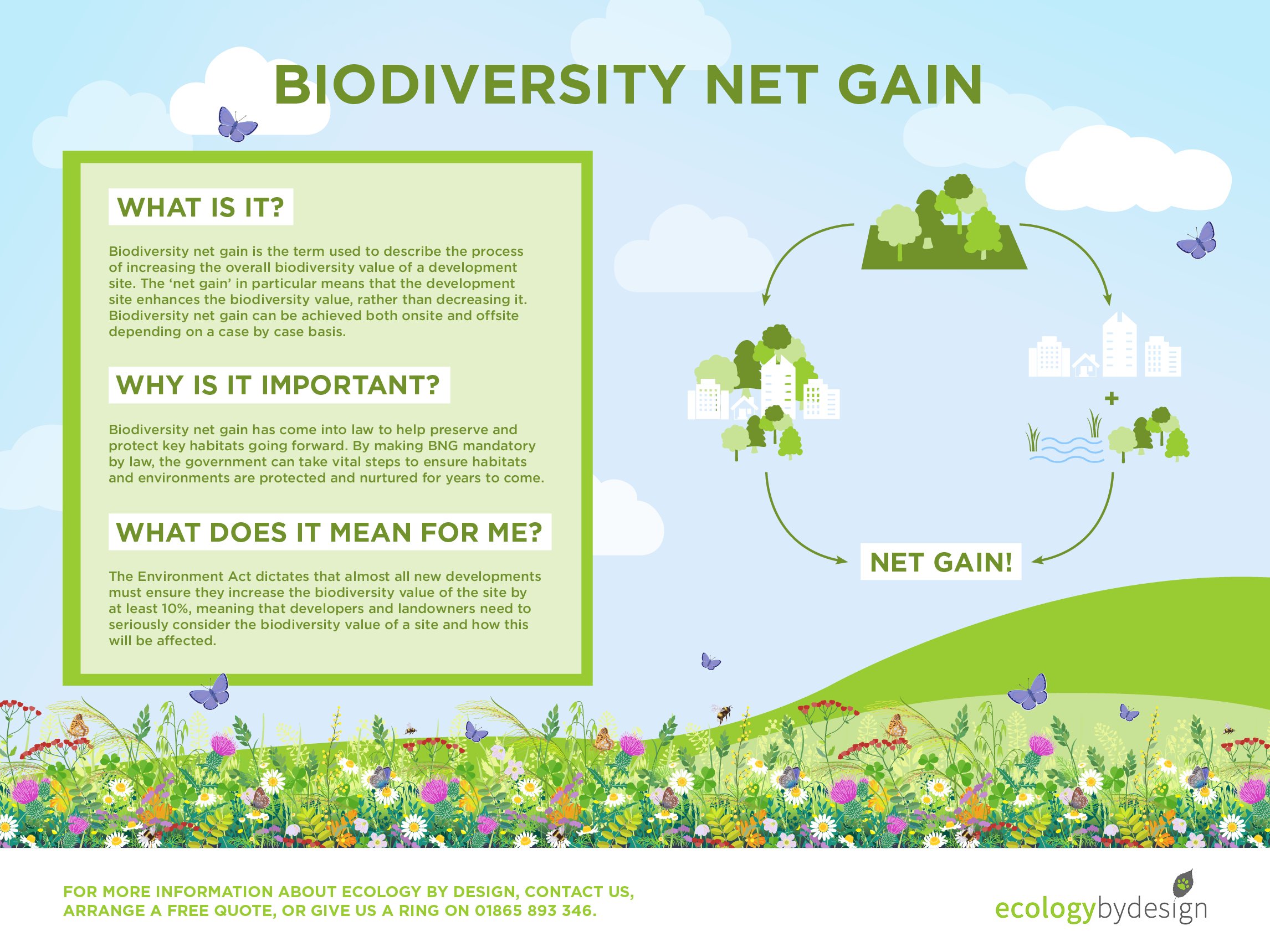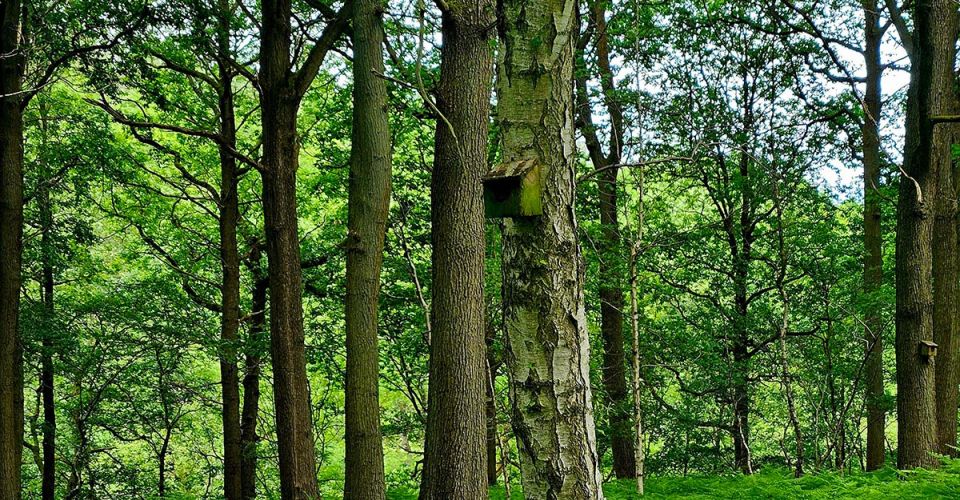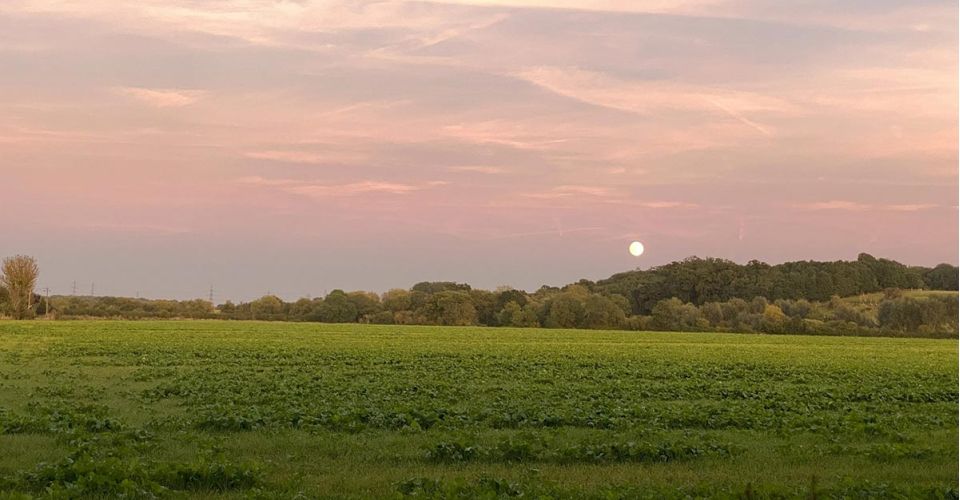Everything you need to know about biodiversity net gain
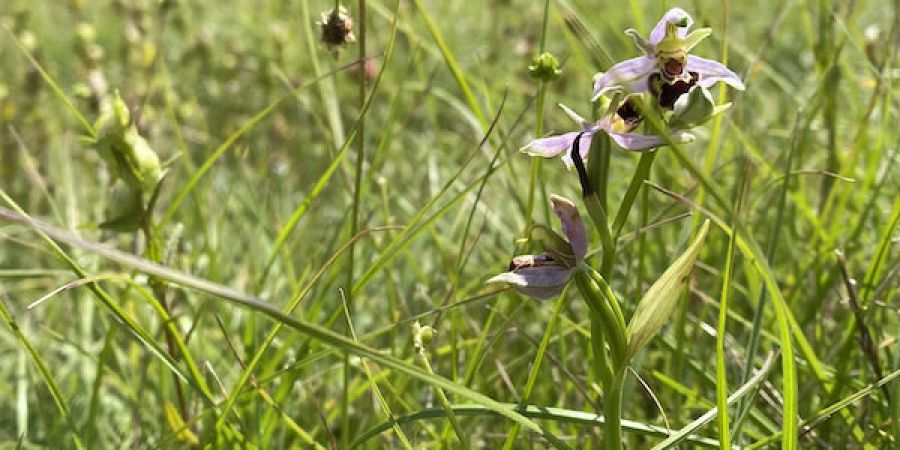
Since February 2024, it has been a legal obligation for developers to consider the environmental impact of their development and ensure the biodiversity is left in a better state than before. It is now law for developers to demonstrate the steps that have been taken to either preserve, protect, mitigate, or enhance any habitats found on site. This may include an increase in natural habitats and ecological features over time, which goes above the habitat originally on site.
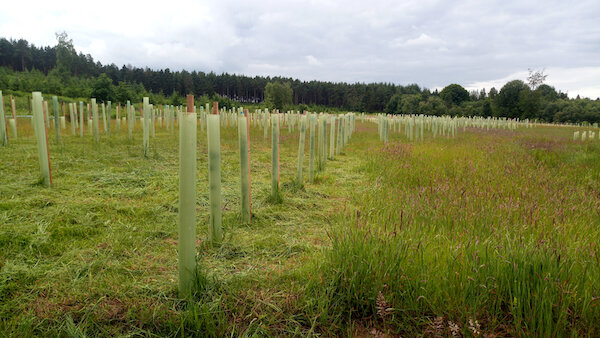
In this guide, we take a closer look at what this means for developers and discuss how to achieve biodiversity net gain with your upcoming project.
Explore our biodiversity net gain services
What is biodiversity?
Biodiversity refers to the existing ecosystem of an area which may be damaged or affected by planned or sought-after developments. As protecting the environment and preserving key habitats becomes more and more important, this has become one of the key considerations in any new development is biodiversity. Biodiversity refers to the existing ecosystem of an area which may be damaged or affected by planned or sought-after developments.
What is biodiversity net gain?
Biodiversity net gain is the term used to describe the process of increasing the overall biodiversity value of a development site. The ‘net gain’ in particular means that the development site enhances the value by completion, rather than decreasing it. Biodiversity net gain can be achieved both onsite and offsite depending on a case-by-case basis.
The mandatory principles of biodiversity net gain
Good practice principles of biodiversity net gain stem from aiming to leave the biodiversity of a site in a better state than it was previously. This has been an optional requirement and was so until the UK government passed the Environment Act in 2021. Within this Act of Parliament, all new developments that apply for planning permission must ensure they increase the biodiversity value of the site by 10% at a minimum.
This new requirement came in to law in February 2024, meaning that developers and landowners need to seriously consider the biodiversity value of a site and how this will be affected. Consulting with planning authorities will be key early on in proceedings. This is to allow time to find a solution to increase biodiversity by at least 10%.
Remember, a development site may not be the appropriate place to implement this increase, which will mean developers need to rely on altering designs or offsite mitigation schemes in order for plans to be granted planning permission.
Since mandatory principles of biodiversity net gain do not specify that biodiversity value needs to increase on the same geographical site, This gives developers increased options, and also means that landowners can capitalise on this new legislation.
What is a biodiversity metric?
A biodiversity metric is just a tool used by ecologists to measure changes in biodiversity. Several such tools have been developed, most recently the Defra Biodiversity Metric 3.1. Crucially, metrics are only concerned with habitats and do not take protected species into consideration.
Metrics assign every habitat on a site a ‘unit value’ according to its relative value for biodiversity. This enables a comparison between the existing value of a site and what will be delivered through development or management.
Biodiversity metrics can help to determine the value of an area of land. This is sometimes referred to as biodiversity banking.
What does a biodiversity metric represent?
The basic aim of completing a metric is to ensure your project increases the overall value of a site. This can be achieved through onsite measures, offsite measures or a combination of the two. If a net gain still isn’t secured it’s possible to pay a commuted sum to a local planning authority or private broker to offset the loss.
The value of a habitat will be measured considering the following factors:
- A habitat’s size
- A habitat’s distinctiveness
- The diversity or rarity of the habitat and species found
- The strategic significance of a site and its ecological importance locally
- The condition and quality of the habitat
- The connectivity of the site and how the habitat is connected to other areas
- The local importance of the habitat site
There is nothing new here; this information has always been an important part of undertaking ecological assessments. Metrics simply provide a rigid structure for how they are measured.
At first glance, biodiversity metrics can resemble a black box. It is not always obvious why certain scores are achieved or how to deliver net gain.
Why was biodiversity net gain bought in?
Biodiversity net gain has come into law to help preserve and protect key habitats going forward. As the 10% increase was previously optional, there was no guarantee that developments would consider the ecosystem in the area. By making BNG mandatory by law, the government can take vital steps to ensure that habitats and environments are protected and nurtured for years to come.
The increase in biodiversity goes beyond planting a few trees; developers will need to demonstrate exactly how their BNG plans will increase the biodiversity value of a site. Local planning authorities (LPAs) are increasingly asking for projects to demonstrate biodiversity net gain clearly, transparently and quantitatively using a biodiversity metric. We will look at biodiversity metrics a little later, Biodiversity net gain must be trackable, with goals and targets set and easy ways to monitor, evaluate and report results to local planning authorities.
How much does BNG planning cost?
 The cost of a biodiversity net gain plan is completely dependent on the size and scope of a project and the options available. If you need ecological services including preliminary site surveys and further monitoring of the habitat, this will be more costly. Based on the findings of a scoping survey, you may then find that you need to conduct a second site survey if a species has been identified. The time of year is also important to ensure you have enough time to complete the survey and take the necessary steps.
The cost of a biodiversity net gain plan is completely dependent on the size and scope of a project and the options available. If you need ecological services including preliminary site surveys and further monitoring of the habitat, this will be more costly. Based on the findings of a scoping survey, you may then find that you need to conduct a second site survey if a species has been identified. The time of year is also important to ensure you have enough time to complete the survey and take the necessary steps.
Read our ecology survey timeline for developers here to find out more about the best times to conduct a survey.
If net gain isn’t achievable on the site itself, then developers will need to find suitable land to use that offers biodiversity value.
How adverse impacts on habitats can be minimised
When it comes to minimising disruption, adverse impacts can either be mitigated, minimised or completely avoided. The early planning stages should determine what’s possible on your site, and identify any constraints regarding improving the biodiversity value. It should be considered within your budget from the get-go, as, once the Environment Bill becomes law, your development will not pass planning permission if net gain is not considered.
Biodiversity net gain can be broken down into the following stages, the exact direction of which is determined by individual circumstances. There is no single measure of biodiversity, and the use of the DEFRA approved biodiversity metric provides a benchmark for all developers to follow to understand the key components of an area’s biodiversity value. Biodiversity net gain can consider air quality, climate regulation and recreational benefits as well as the physical habitat of an area.
Examples of biodiversity net gain
Biodiversity net gain, by definition, is achieved through land management that ensures the biodiversity value achieves a ‘net’ gain. For each habitat type, the amount of habitat required to compensate for the loss on site will vary depending on the habitat's value taking into account its condition, distinctiveness and strategic significance. For high-value habitats, the gain required can be significant due to the value or due to the time it takes for a new habitat to reach the same condition. So for example, if you remove 10 hectares of woodland, it is not as simple as replacing with 11 hectares (i.e. 10%) but will require 120 hectares of new woodland because of the time it takes to establish.
This can become challenging if the development is in a built-up area, or if it causes issues with access or safety. In these instances, the required ‘net gain’ would be achieved by increasing the biodiversity value of another area of land. This brings us nicely to how landowners can benefit from biodiversity net gain.
How can landowners benefit from biodiversity net gain?
As a landowner, you have the opportunity to put your land up to tender to be used by developers to create, improve or re-establish an ecosystem or habitat. Whether that be through planting trees or creating plans for a wetland, hedgerow, pond or area of wildflowers.
Biodiversity net gain can greatly benefit landowners in that it offers scope for landowners to secure measurable gains by selling or leasing land to a developer, biodiversity broker or local authority. If you are a landowner with woodland and grassland, it could be potentially eligible for use for offsetting. Not only are there profitable benefits to this, but it will mean you have played an important role in helping to protect, restore and enhance biodiversity in your area.
How to achieve biodiversity net gain
Biodiversity net gain is achieved through presenting findings through metrics. Biodiversity metrics allow local planning authorities (LPA) to assess the biodiversity potential of a site and ensure the correct percentage of biodiversity net gain is achieved. BNG metrics allow for a universal way to measure biodiversity that can be used across the board.
It may be the case that a development site is not suitable for the creation, restoration and enhancement of habitats. In this case, a developer may need to find an appropriate woodland or grassland within the local area or beyond. Suppose a developer can demonstrate that the required amount of net gain can be achieved. In that case, the development can go ahead with the assurances that any habitats that are interfered with or damaged are replaced.
Compensation for biodiversity loss must be clearly and coherently mapped out before any development work begins. This allows stakeholders, landowners, local planning authorities, consultants, contractors, operators, maintainers and more to invest with confidence in the knowledge that the right steps have been taken.
It may be the case that biodiversity net gain may not be possible to achieve onsite. In this case, offsite compensation may be involved. This isn’t all bad, though, as it can help you to develop a net gain ‘legacy’ through the development of large areas for wildlife conservation.
What to consider to achieve biodiversity net gain
Below we touch on some of the factors you will need to consider when putting in place a plan for biodiversity net gain.
- The feasibility of the project
- Any risks involved in the project (ecological, logistical, financial)
- Ensuring you have enough resources and budget
- The timeline of the project
- Assessing the quality and extent of specific features
- Measuring any potential negative effects of a project, be that direct, indirect, temporary, permanent or cumulative
- How the build can maximise public benefits.
Integrating biodiversity net gain into a planning application, a development plan enables local authorities to deliver high-quality, sustainable developments within their area. Local planning authorities rarely contest against biodiversity net gain, as such plans ensure LPAs are making a meaningful contribution to achieving biodiversity.
By targeting biodiversity enhancements where there is the greatest need for biodiversity restoration, BNG plans provide an opportunity in more ways than one. Developers can make a positive impact on the community, especially as local plan policies can help ensure that any net gain is established considering local biodiversity needs and priorities.
Why are stakeholders on board with biodiversity net gain?
Stakeholders actually have a lot to gain from biodiversity net gain; there are plenty of benefits to investing time and effort in mitigation plans. Not only does it demonstrate a sense of corporate social responsibility, but it also provides a positive, proactive solution. Actively seeking a solution can reduce delays with the planning application stage and can open doors for biodiversity gains that would otherwise not occur.
Unavoidable biodiversity loss can be countered through distinctive, attractive, well-designed and sustainable areas within a new development or community. Communities and businesses can thrive in such areas bringing a boost to the local community and contributing to a range of opportunities that can be gained for the local area.
Biodiversity net gain plan
- Define business decisions in the context
- Set biodiversity goals and targets
- Explore and set management actions
- Develop or select indicators
- Monitoring, evaluating and reporting
- Adapting and refining
How Ecology by Design can help
As biodiversity gain experts, we can help you to understand the scope of your site, and conduct initial habitat surveys including preliminary ecological appraisals and ecological impact assessments to help you to identify the best way forward. We can also identify suitable sites for biodiversity offsetting if net gain isn’t entirely achievable onsite. We’ll work to find you the most efficient solution and liaise with planning authorities, estate owners and other stakeholders to ensure the best possible outcome.
Benefits of biodiversity net gain
The immediate benefits of net gain can go beyond improving the ecosystem or wildlife conservation. Improved air quality, flood management, and soil stability are just a few of the other advantages of BNG. Looking forward, a solid focus on climate change is as important as ever, and plans that will enhance an area for wildlife will naturally boost your reputation and demonstrate that sustainability is top of mind with your project- an attractive quality for stakeholders. High-quality spaces can be created that offer financial value as well as commercial or residential spaces, bringing a sense of community that can enhance wellbeing and quality of life for residents.
It’s important that developers take the time to develop a programme for designing, implementing, maintaining and monitoring biodiversity net gain, especially to highlight the timescales involved.
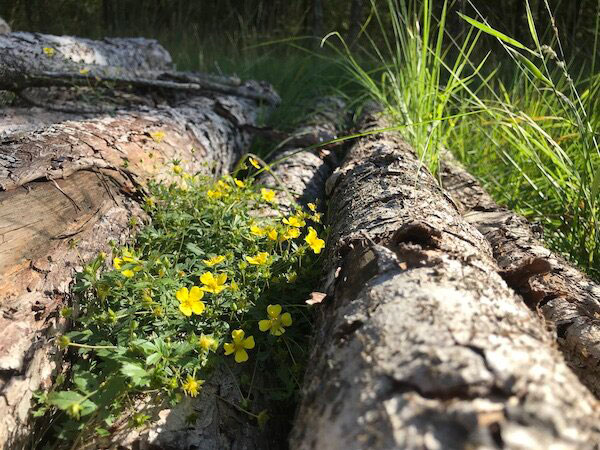 How can you prepare for biodiversity net gain?
How can you prepare for biodiversity net gain?
- Have the most appropriate stakeholders and partners been identified?
- Have all data source options been explored?
- Have the exact benefits and net gain for biodiversity been defined?
- Has the minimum amount of biodiversity net gain possible been identified?
- Will the BNG to be implemented correlate and complement the biodiversity in the immediate neighbouring local area?
- Have all possible eventualities to increase BNG onsite been explored, and if so, have the best opportunities offsite been determined?
Ecology by Design has extensive experience completing metrics for a wide range of developments and is well acquainted with the pitfalls and opportunities they create. We can work with your landscaping teams to maximise the value achieved by your project and minimise or eliminate the need for additional compensation wherever possible.
We can also help place the biodiversity metric in the wider picture. It is only one part of the ecological assessment process. It does not replace the mitigation hierarchy, nor account for protected species. Professional judgement is as important as it has ever been.
If you think you may benefit from Ecology by Design’s services, reach out to us today. You can find out more about Ecology by Design’s Biodiversity Net Gain assessments here.
Biodiversity Net Gain - FAQs
Is it a legal requirement to achieve biodiversity net gain?
The Environment Act of 2021 was granted Royal Assent on 9th November 2021, and it became law in February 2024 for all developments to achieve at least a 10% increase in biodiversity net gain. Developers will need to consider net gain prior to applying for planning permission.
Should we ignore it until then?
No. Net gain already features in multiple levels of planning policy, starting with the National Planning Policy Framework (NPPF), which requires planning policies and decisions to provide net gains for biodiversity.
The NPPF does not explicitly require the use of a biodiversity metric. However, many local planning authorities (LPAs) have introduced such a requirement in their own policy frameworks.
Crucially, there are differences between the LPAs. Some simply require gains to exceed losses, whereas some require 10% net gain and some higher. Different LPAs prefer different biodiversity metrics. We will always establish these requirements early on in a project’s life cycle.
What are the different biodiversity metrics?
The Defra Biodiversity Metric 3.1 was released in 2022 and it is Natural England’s intention for the metric to become widespread over time.
Some LPAs have developed their own metrics. This includes the Warwickshire County Council, where an initial biodiversity offsetting pilot was run from 2012-14, and the Dorset Council. However, this metric is slowly being phased out and replaced by the Defra metric above.
Who completes the biodiversity metric?
It is the developer’s responsibility to submit a completed metric with an application. In practice, it should be completed by an experienced ecologist who is not only aware of how the metrics work but the pitfalls and opportunities associated with them.
We have experience completing metrics for a wide range of developments and would be happy to advise on what requirements your project will need to meet and how to maximise your site’s score and achieve meaningful gains for biodiversity within the site.
Benefits of the biodiversity net gain metric
- Less difficult in verifying that a calculation is accurate
- More transparency and easier comparison across different developments
- Increased ability to encourage a focus on nature conservation priorities
What is a biodiversity unit?
In short, it is a unit of account. Metrics assign all habitats a unit value according to their relative biodiversity value (e.g. species-rich grassland is more valuable than species-poor grassland).
The scores assigned to habitats vary between the different metrics. There are some commonalities, and in all cases, this score is influenced by the size, distinctiveness and condition of the habitat.
There are two different types of biodiversity units:
Area units - e.g. grassland, woodland
Linear units - e.g. hedgerows, rivers
These are treated separately in biodiversity metrics and it is usually necessary to achieve net gain in both measurements.
This means the loss of a hedgerow cannot be offset by creating grassland, woodland or a pond elsewhere; it must be offset by enhancing retained hedgerows or creating new ones.
Why are hedgerows treated differently?
One of the criteria that influences biodiversity value is habitat size. Size is captured in biodiversity metrics through an area measurement. As the area of any habitat increases, so too does its value.
Hedgerows are treated differently on the basis that an area measurement does not capture their real biodiversity value. Indeed, they are usually taller than they are wide, while their value can depend more on their structure than their extent.
As such, they are assessed using a different part of biodiversity metrics reserved for linear features. The score assigned to a hedgerow is expressed in hedgerow units.
Do the metrics work for all habitats?
No. There are some, such as Ancient Woodland that is excluded from the metrics. Similarly, the metrics cannot be used to assess statutorily designated sites (Sites of Special Scientific Interest, Special Protection Areas, Special Areas of Conservation etc.).
What about protected species?
Protected species are not included in any biodiversity metric at present and are unlikely to be included any time soon. However, the district licensing scheme being rolled out in some local authorities works on similar principles.
What happens if you complete a biodiversity metric and it shows a net loss?
In the first instance, it may be possible to increase the biodiversity units achieved through changes to landscape plans or the master plan. Alternatively, it may be possible to provide offsite compensation by delivering biodiversity benefits on other land within your control.
If these approaches are not viable or sufficient then financial compensation can be agreed upon with the local planning authority as a last resort.
How much will it cost me to offset a net loss?
There is no fixed price for a biodiversity unit. Only the metrics produced by the Warwickshire County Council and Dorset Council convert a net loss into a figure for financial compensation.
There is no national approach. It will be left to each planning authority to determine financial compensation for themselves. At Ecology by Design, we are experienced in negotiating with authorities to determine an appropriate outcome that ensures net gain while achieving certainty for our clients.
Where will the offsetting money go?
This will depend on the LPA. It will ultimately be spent on a nature conservation project on land within that authority’s jurisdiction. Each LPA will have different priorities based on local circumstances.
There are private companies that can act as a broker to deliver biodiversity offsets on your behalf. We are happy to liaise with such companies to streamline the process for you.
For more information about Ecology by Design, head to our blog or discover our ecology services.
